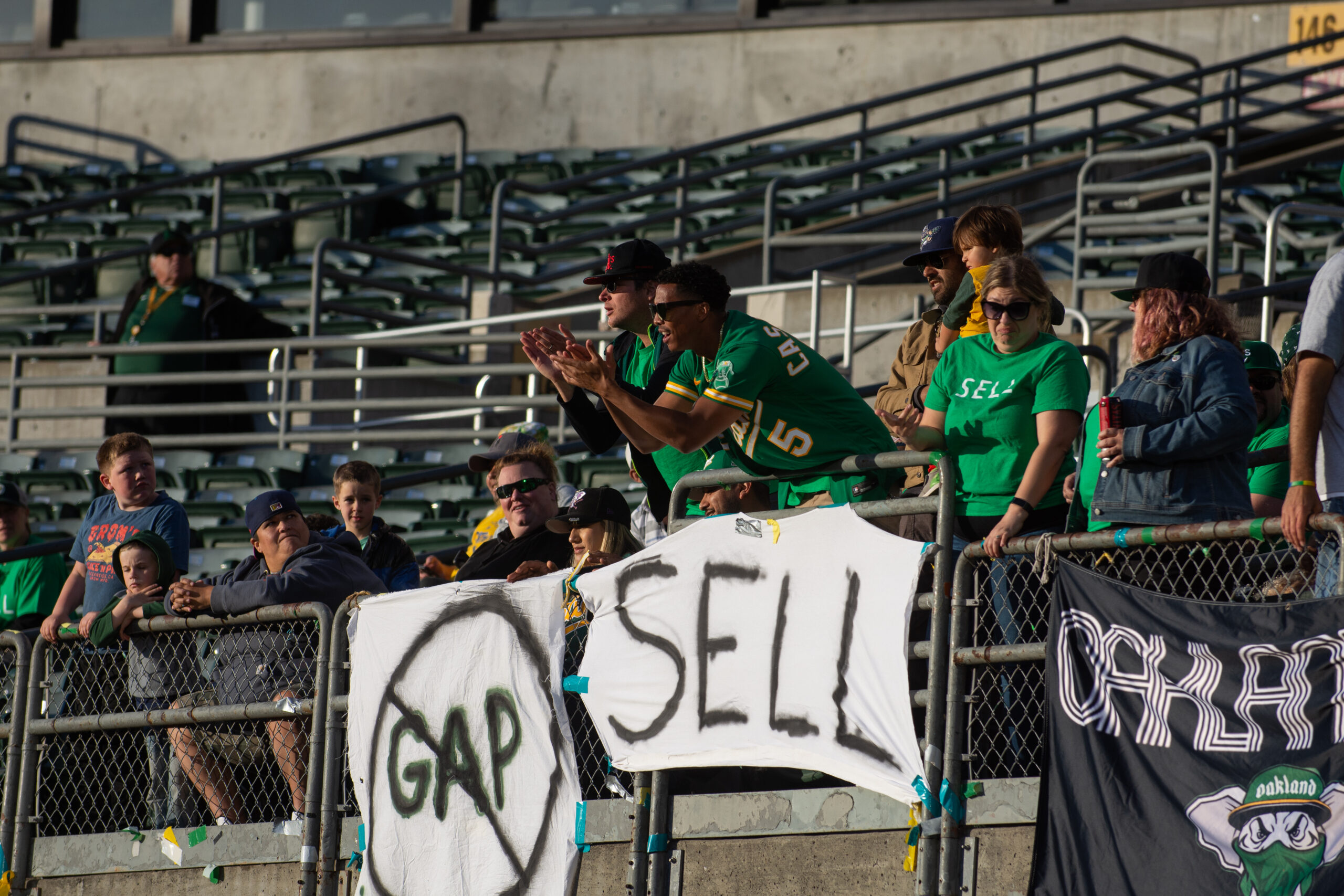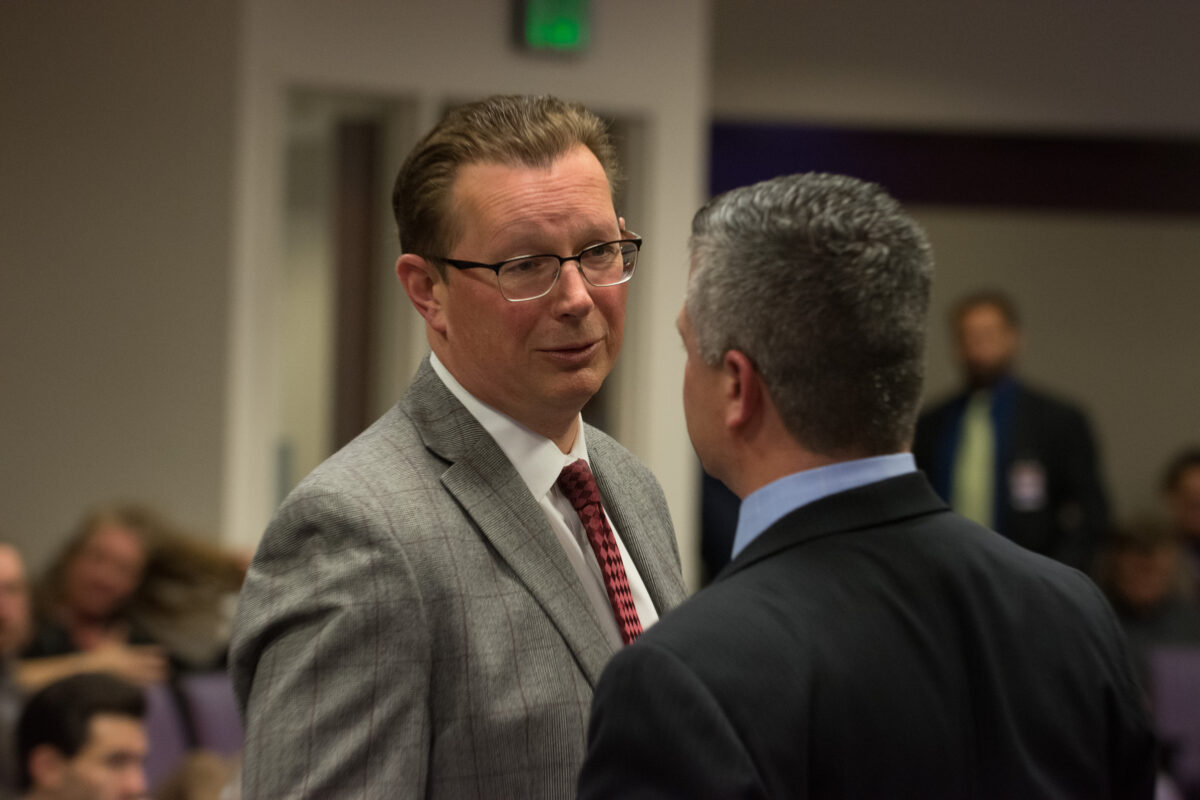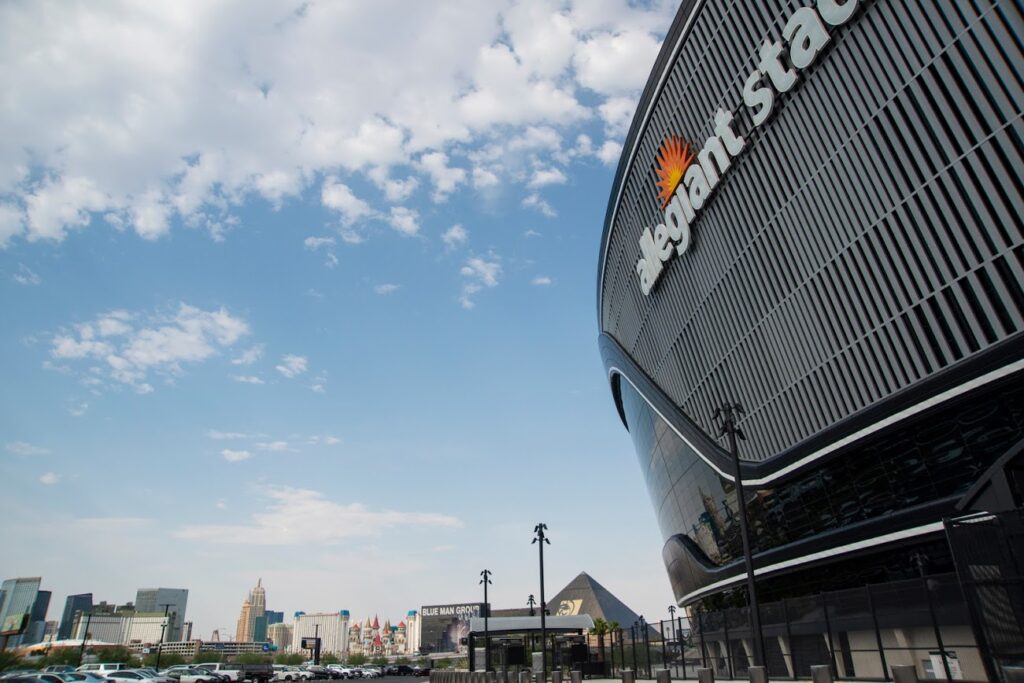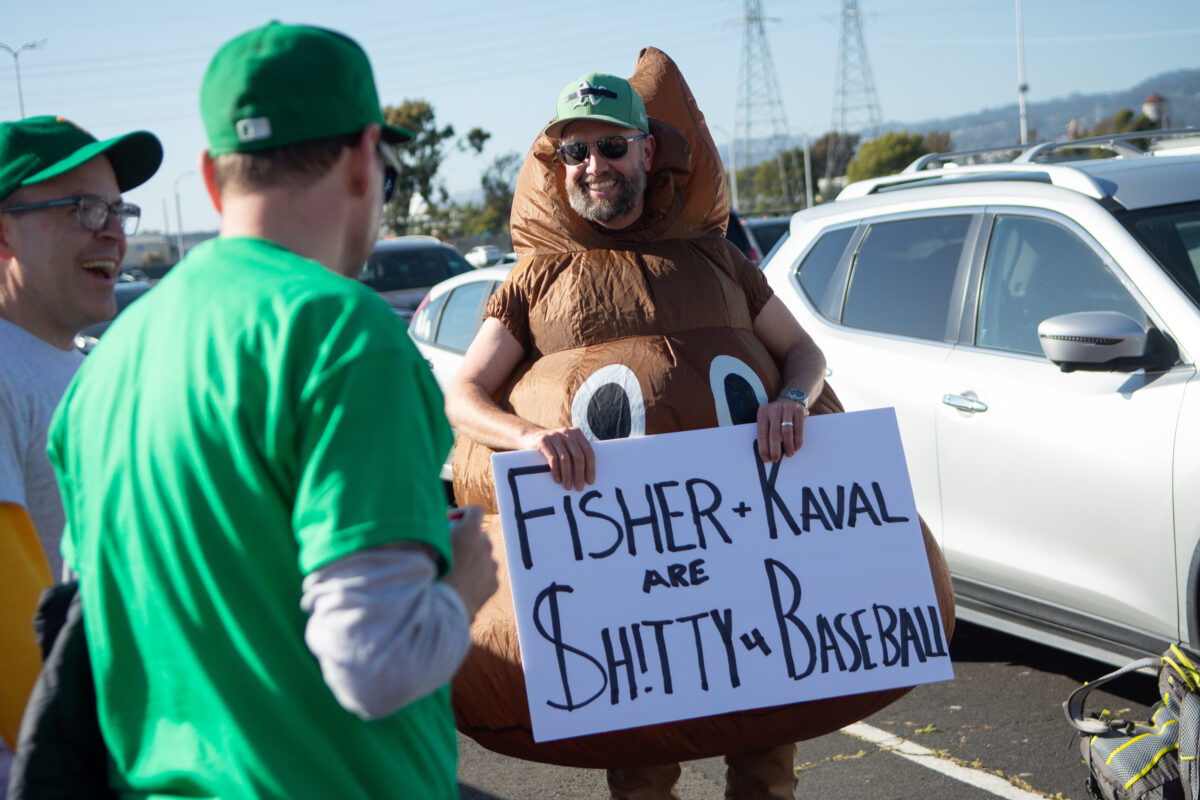Sports economists pan public funding for A’s ballpark deal as ‘standard stadium grift’

While images of a near-empty Oakland Coliseum, protests of the Oakland A’s ownership and confusion about new stadium sites have grabbed headlines, proponents of a hotly contested bill to establish a $380 million public funding mechanism for a $1.5 billion, 30,000-seat baseball stadium in Las Vegas argue the project will ultimately be a worthwhile investment generating jobs, tourism and, ultimately, revenue for Clark County and the state.
But as SB509 moves through the Legislature, sports economists have rebuked those arguments and pointed to numerous studies showing that the costs to taxpayers are not worth the benefits of publicly financing a multibillion-dollar entertainment venue.
“Most spending that happens in and around stadiums is just reallocated local spending, so there doesn't seem to be much net positive economic impact from the stadium,” J.C. Bradbury, a sports economics researcher and professor at Kennesaw State University in Georgia who authored The Baseball Economist, said in an interview. “Anyone who is telling you that there is an economic benefit to a stadium deal is [lying] … I've studied this to death. There's universal agreement.”
Under SB509, direct public financing for the stadium project is capped at $380 million — a combination of $180 million in transferable tax credits from the state, upward of $120 million in bonds from the county and a $25 million credit from the county for infrastructure costs around the stadium — which would be largely paid off by revenues generated by the stadium over 30 years. That amount does not include a property tax exemption also proposed for the project, common for stadiums across the country but potentially valued at tens or hundreds of millions of dollars over the lifetime of the stadium.
Despite research showing that stadiums have little positive economic impact on local economies and are a poor public investment, those supporting the bill argue Las Vegas is different.
“If you build a stadium in most places around the United States, it is going to have a negative economic impact,” Jeremy Aguero, a principal analyst at Applied Analysis, which the A’s have hired to consult on the proposed Las Vegas stadium deal, said during last week’s hearing of the bill. “While those statements are 100 percent right for markets that don't have 40 million visitors, they are 100 percent wrong for ones that do.”
Aguero, who briefly worked as chief operations and analytics officer with the Las Vegas Raiders, argued that Las Vegas is a completely different sports economy with a market heavily reliant on tourism and the ability to leverage 150,000 local hotel rooms to bring in more tourists for sporting events.
“We develop this benefit that allows us to do things that other places cannot, and I'm not up here to tell you that I can tell you with 100 percent assurance that that is what is going to happen here. I can't,” he said to lawmakers. “But … we've made bets, and we've won a lot.”
Many fans have also aired grievances with using public funds for financing — a May poll from The Nevada Independent and Noble Predictive Insights found that opinions roughly split on using taxpayer dollars to support stadium development, with 41 percent in support and 38 percent opposed.
Stephen Miller, research director at UNLV’s Center for Business and Economic Research, expressed a similar skepticism as Bradbury, saying “economists don't agree on many things … but on this particular issue, it's pretty close to agreement that public funding of stadiums is not a good idea.”
“However, Las Vegas may be the exception,” he said.
The lack of consensus stems in part from having little information about the Las Vegas sports economy. Until 2017, when the Vegas Golden Knights were formed and started to play hockey at the privately funded T-Mobile Arena, the city was one of the largest markets in the country without a team from one of the four major leagues. The city’s new football field at the 65,000-seat Allegiant Stadium — funded with $750 million in public money, one of the highest amounts in U.S. history — only opened in 2020.
If Las Vegas lands the A’s, it would become the smallest television market in the country with three professional teams from the four major leagues.
Even with a smaller television market, Aguero and Steve Hill — CEO and president of the Las Vegas Convention and Visitors Authority and chair of the Las Vegas Stadium Authority, which would oversee the A’s ballpark — highlighted the high volume of tourism in Las Vegas that makes it different from other cities, and framed a new baseball stadium as another major attraction for the Las Vegas Strip.
But Bradbury, who has extensively reviewed research on publicly subsidized stadiums, pushed back on claims that Las Vegas could be the exception.
“People will always say, ‘Oh, but this one is different.’ Every single stadium deal I've ever looked at the people who are supporting this say, ‘This one will be different.’ And when we look at it 15 to 20 years later, it's exactly the same as they always are,” he said. “There's always an excuse, and the reason is that there's a lot of money to be made by getting this stadium funded. And so the owner is going to benefit tremendously.”
With a historically bad team — the A’s this year have been on pace for the worst record in a 162-game season in the history of the major leagues — and rocky negotiations with the city of Oakland, Victor Matheson, a sports economist and professor at the College of the Holy Cross in Massachusetts, called it “embarrassing” that the team could potentially land a deal for hundreds of millions of dollars in public money for a Las Vegas stadium, though he added that the proposal for the A’s is fairly low compared with other recent public stadium financing.
“The fact that anyone in [Nevada] gave them a dime when the team has literally nowhere else to go is the worst bargaining in the world,” Matheson said. “Quite honestly, I would have just squeezed them … It's not about being friendly to the A's, it's about looking out for the taxpayer.”

Is a stadium a bad investment?
Miller said putting public dollars toward a stadium draws away from funding other government services.
“The question is, are you going to take money away from some other program in the state in order to fund the stadium? And how important is that money for the other program? You're making a choice, and indeed, there is a trade-off,” Miller said.
Matheson, who also previously served as an editor at the Journal of Sport Economics, agrees.
“We [sports economists] all agree that the ideal amount of public funding is either zero or awfully close to zero,” Matheson said. “These are typically just gigantic giveaways to billionaire owners at the expense of taxpayers. It’s the sort of thing we generally wouldn't do for other types of entertainment venues, other types of retail venues.”
Matheson said there could be some justification for a smaller subsidy in the range of the tens of millions of dollars, but he said those would best be directed to infrastructure, such as transportation around the stadium.
“You can make a little bit of a claim for the public good aspects, as well. Having this be an amenity and … you get civic pride around a sports team,” he added.
Miller noted there are some beneficial spinoff effects from stadiums, pointing to a recent white paper he co-authored at UNLV on the local sports economy, including positive effects of professional sports on local marketing and youth sports.
But Matheson and Bradbury both highlighted that the stadium would redirect spending away from other parts of the local economy, with local baseball game attendees spending money that simply goes into paying off the stadium rather than being collected through other taxes that support other government services.
“Most people who are coming to A’s games … you will have people who are local Las Vegas A’s fans, but you may have people who are in town, instead of going to see a show at a casino, they'll go to a baseball game. That’s money that would have been collected in Nevada and spent on other things,” Bradbury said.
Bradbury said that includes “casual fans,” who may be in town and decide to go to a baseball game, and “time switchers,” someone who may align their annual trip to Las Vegas with when their favorite baseball team plays the A’s. He said those visitors would have already spent their money on the local economy.
Those who make the trip to Las Vegas for the purpose of a special event at the stadium are “incremental visitors,” and make up just a small chunk of all stadium attendees in a year. Supporters of the bill project the stadium could generate 405,000 incremental visitors per year, or about 16 percent of all attendees in a year. They also estimate that from 81 regular season A’s home games alone, the stadium could bring in more than 2.4 million visitors — an amount that would be the highest in decades for the team with the worst attendance in the major leagues, bringing in fewer than 800,000 attendees during the 2022 season.
Though Matheson said that baseball can generate some additional tourism, even up to “a few hundred additional hotel room nights” in baseball cities such as Minneapolis and Cleveland because tickets are affordable, he said games could actually contribute to a loss in tax revenue because someone could spend $25 to see a baseball game versus “spending $200 going to Britney Spears or spending way more than $200 losing the money in the casino.”
“To the extent that this just shifts around where the existing tourists are spending their money, this could be a pretty big net negative,” he said. “And again, it’s not clear to me that people are saying, ‘Hey, you know, I never thought about going to Vegas, but now that they have a baseball team, I might.’ That doesn't seem like a very good argument.”
Neil deMause, the author of Field of Schemes, a book about public subsidies for stadiums and the name of a companion website for sports stadium news and analysis, also expressed skepticism over the projected attendance numbers. He argued that Las Vegas does not need the team to bring in visitors to an already popular destination, and he pointed to studies showing that in other popular tourist destinations such as Florida in the spring, a loss of baseball (such as the temporary stoppage of Spring Training during a lockout season) has not had a negative impact on tourism.
Still, supporters of the bill believe it will have a positive return on investment, including Gov. Joe Lombardo’s Chief of Staff Ben Kieckhefer, who last week said, “the state general fund will make money on this deal.”

Differing job projections
Aguero’s presentation of the bill included projections that the one-time construction of the stadium would generate nearly 15,000 jobs, and that annual operations would create 8,000 full-time and part-time jobs through both the direct and indirect economic impact of the project.
But Matheson pushed back on those claims, noting that with a low unemployment rate, the city is “not likely to have gigantic numbers of unemployed construction workers and heavy construction workers just sitting around waiting for a stadium.”
Though the number of employed construction workers in Las Vegas has remained relatively flat during the past nine months, it is at its highest level since 2008, when the Great Recession tanked the state’s construction industry.
Allegiant Stadium was originally projected to create nearly 11,000 direct construction jobs and nearly 19,000 jobs total through the development process. Though Hill, the chair of the Stadium Authority, said last week that “projections that we made at Allegiant Stadium have been vastly overperformed,” the company that managed Allegiant Stadium construction reported employing 12,000 workers for the project, a slight increase over projections. Aguero said part of the reason the project surpassed expectations “was because the project itself became more expensive.”
However, in terms of annual operations, the stadium has fallen just short of projections that it would directly employ more 4,000 workers and create 6,000 total jobs through indirect and induced impacts. At last count, the stadium employs about 3,800 workers.

Matheson said baseball stadiums typically employ less than 500 workers and “the vast majority of those workers are minimum wage” — holding positions such as hot dog and beer vendors and ushers — while the general manager and players are the ones with the high-paying jobs.
With lingering questions about the employment projections and what revenues the stadium could produce, lawmakers last week also raised questions about whether a stadium is the best use of the proposed site — which lies on a prime piece of Las Vegas Strip real estate at the corner of Tropicana Avenue and Las Vegas Boulevard across from the MGM Grand.
If another casino were to occupy the land — in place of the soon-to-be-demolished Tropicana — that property could potentially generate taxes directly for the state and county that would not be redirected toward paying off the development.
Supporters of the bill have argued that with a 30,000-seat stadium, the site could be used for certain large-scale events that do not quite fit the size of the 65,000-seat Allegiant Stadium but are too large for other local venues.
Aguero’s presentation highlighted nearly 15 non baseball events that could take place at the stadium annually, such as concerts and other sporting events, though proponents argue that number is a low-end projection.
But economists cautioned that stadiums of that size do not necessarily bring in lots of other events.
“The actual added events for stadiums are very few and far between. It's certainly not enough to justify the level of public funding that's received,” Bradbury said.
Allegiant Stadium, however, has been a big draw, bringing in 1.7 million visitors last year, including a large number of tourists.
Details of stadium financing
Before any of the $380 million in public funding can be used to support the development of the stadium, the A’s (and any developer they partner with) must pay for the first $100 million in costs for the project.
Only then could Clark County kick-start a process of issuing bonds for the project — likely upward of $120 million and potentially up to $175 million if the state issues the maximum amount of tax credits.
The A’s and others involved in the project would also have to meet several requirements before the Stadium Authority requests that county commissioners issue the bonds. That includes proof of a financing commitment from the A’s or their developer partner sufficient to pay for the cost of the stadium. Another requirement includes the county’s creation of a sports and entertainment tax district that pledges use of the stadium revenue to pay off the public financing portion of construction costs.
That district would pay off the bonds through tax-increment financing (TIF), also known in this case as a “mega-TIF” because all tax revenues and fees generated within the district — drawn around the 9-acre stadium site — would pay off the financing from the county and state.
“No increase in revenues. No new revenues are created in this financing plan,” Aguero said during a hearing of the bill last week. “Sales tax, Live Entertainment Tax, the payroll tax and many other taxes and fees will flow into a sports and entertainment improvement district. Those dollars will be used to offset bonds. They’ll be issued and secured by those.”

The county would also be required to provide a $25 million credit through the development agreement to address infrastructure needs at the site.
As part of the final chunk of public financing, the bill would allow the state to issue up to $180 million in transferable tax credits to the A’s for the project, at a maximum of $36 million in credits annually. Revenues from the tax district would be used to pay the state back for the amount exceeding that $90 million — meaning if the A’s receive the maximum $180 million in credits, half of that amount would be repaid via revenues from the stadium. Requiring credits to be refunded to the state has not been done before in Nevada.
The credits could not be used by the team itself because transferable tax credits may only be used against gaming license fees (which the organization would not pay as a non gaming business), payroll taxes and insurance premium taxes, which would both be captured in the tax district and redirected to pay off the bonds.
Instead, that leaves the A’s to sell the transferable tax credits to other businesses. However, such credits are typically not sold at a one-to-one ratio, meaning they could be sold at 60 cents on the dollar, for example. Businesses that have received credits from the state in the past, such as the $195 million in transferable tax credits issued to Tesla, have often sold them to major gaming companies in Las Vegas.
So for example, if the A’s sold $50 million in credits at a rate of 90 cents per dollar, the A’s would receive $45 million in cash to fund the development of the stadium, while the buyer could use the $50 million in credits to offset its tax liability. Though the state would issue $50 million in credits to the A’s — with all of those dollars counted against the state’s general fund balance otherwise spent on other government services — just $45 million would actually go toward stadium costs.
Using transferable tax credits is unusual for funding sports stadiums, deMause said, noting that through the selling process, it reduces public benefit provided to the A’s, while not reducing the cost of the stadium.
Not all potential taxes would be captured by the district to go to paying off the credits or county bonds. The stadium land would be exempt from property taxes, a common feature for stadiums around the country, Matheson said, but he added that could be “hundreds of millions of dollars of cost over the life of the stadium.”
Also subtracted from the stadium revenue would be the Live Entertainment Tax for A’s home games. Under state law, professional sports teams playing home games in the state are exempt from the Live Entertainment Tax.
“Every financing package is unique because they are all kind of geared toward avoiding whatever the particular red flags are that will cause problems in that particular state Legislature,” deMause said.
In Nevada’s case, Lombardo has said he will not raise taxes — leading to an arrangement supported by the governor that would instead redirect taxes to pay off the stadium. But deMause pointed out that the proposal still draws tax dollars away from other services, and noted there are only two ways to make up for a tax break — cut spending or raise taxes. With no new taxes, the breaks for the stadium mean less money for other government services.
With most taxes captured within the stadium district, the bill’s backers estimate the project will generate nearly $39 million in tax revenue through one-time construction costs of the project, such as through sales tax on building materials, and $17 million in tax revenue through annual operations of the stadium.
If the projects’ revenues come in at or over expectations, those dollars would be distributed through a “waterfall” over 30 years, Treasurer Zach Conine said during the bill presentation last week. The waterfall would start with payments on the principal and interest of the bonds issued by the county, then going toward the following expenses:
- Operating costs for the Stadium Authority
- Completing construction of the stadium if the developer pulls out and does not complete development of the project
- Filling the second year of reserves to backstop the bonds, which Conine said would “be filled during construction from the sales taxes generated by the construction proceeds.”
- Repaying any draws from the state’s line of credit, which may be issued to help the county obtain better terms on the bonds
- Repaying any draws from the bond reserves
- Paying upward of $5 million annually to a capital reserve fund, which Conine said would help “to make sure the stadium remains world-class” and that the A’s would be expected to make a matching contribution.
- Repaying transferable tax credits in excess of $90 million to the state
- Paying $5 million to a homeless prevention and assistance fund
- Making any additional investment of repayment of bonds
“It's very familiar from other places. The [Atlanta] Falcons used that to great effect,” deMause said of the allocation to the capital reserve fund, pointing to the Falcons’ ability to use extra hotel tax money in a similar waterfall fund for maintenance and improvement of their new stadium, with costs totaling hundreds of millions of dollars.
If revenues from the stadium district fall below expectations, the reserves and debt service coverage (such as the state’s line of credit) would first be used to support the bond payments, before the county would have to dip into its own reserve to support the bonds.
Bradbury acknowledged that “the Legislature and local governments have to present some level of accountability for funding,” adding that “the financing works out because it has to by law.” But he argued that won’t mean the project has a positive impact on the local economy.
Also still in question is whether the team will put out a quality product that fans will want to watch. The A’s are the worst team in the major leagues, with the lowest payroll in professional baseball. The two executives spearheading the relocation, owner John Fisher and President David Kaval, have been in a similar position before when negotiating with Oakland officials for a new stadium and still not increased funding for payroll.

Fisher is also the owner of the San Jose Earthquakes, a Major League Soccer team that Kaval helmed as president in the early 2010s. Since moving into a new stadium in 2015, the team has not once won more games than it lost, and in recent years, the team’s payroll has sat in the bottom third of the league.
Bradbury described the proposal for the Las Vegas ballpark as “unserious” compared with other stadium efforts he’s seen, pointing to confusion over multiple binding agreements for land for the project and the short timeline for pushing forward the idea — SB509 was introduced with only a week and a half left in the legislative session, and received its first hearing on Memorial Day.
“This is the same story that happens over and over,” he said. “If sports stadiums were economic engines, then when economists would go and look at studies, it would be obvious, and they never are … So this is your standard stadium grift, no one should fall for this.”
Noel Sims contributed to this report.
